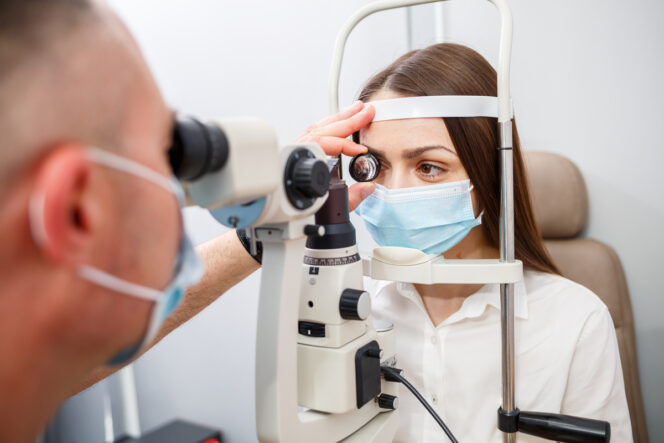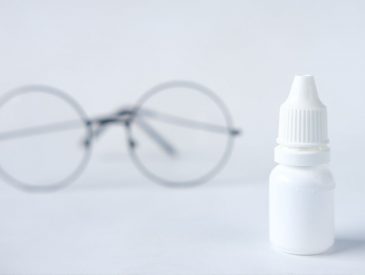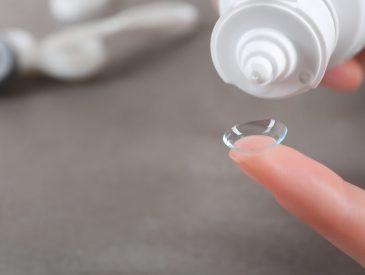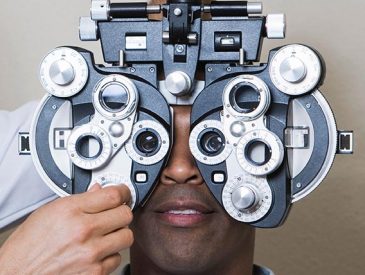A nearsighted, farsighted, or astigmatic refractive error in your vision can be identified by an eye refraction test administered by an optometrist or ophthalmologist.
A 20/20 reading is typically regarded as ideal or perfect vision. Letters that are 3/8 of an inch tall can be read from 20 feet away by people with 20/20 vision.
You have a refractive error if your vision isn’t 20/20. A refractive error occurs when the lens of your eye does not bend light properly. Your doctor will be able to prescribe the correct lenses for you based on the results of your refraction test so that you can see clearly 20/20.
For more specific information, keep reading.
Table of Contents
How Is Eye Refraction Test Conducted?
An optometrist or ophthalmologist conducts this test. Both of these experts are frequently referred to as “eye doctors.””
A special chair with a phoroptor or refractor attached to it is where you sit. A 20-foot (6-meter) eye chart comes into sharp focus as you peer through the apparatus. It has lenses that you can move into your field of vision and has lenses of various strengths. One eye at a time is tested during the procedure.
- The results will depend on your responses when the eye doctor asks if the chart appears more or less clear with different lenses in place.
- The next step involves a device that determines your refraction while also shining specialized light into your eyes. I don’t need any responses from you. Every refraction type has advantages of its own.
Eye Refraction: What Is It?
The measurement of an individual’s eye refraction determines the necessary power for their glasses or contact lenses. This is calculated by means of a refraction test (also known as a vision test), typically conducted as part of a standard eye examination. A refraction test provides a doctor with the precise measurement needed to write a patient’s prescription for glasses or contact lenses.
According to the American Optometric Association, 20/20 vision is a common way to describe having perfect vision. This means that a person can see clearly at 20 feet what they normally should be able to see at 20 feet away. As opposed to this, 20/100 vision requires a person to be 20 feet away in order to see what someone with “normal” vision can see from a distance of 100 feet.
Refraction tests are used to calculate these measurements.
20/20 Vision
Refractive errors, which occur when light rays do not bend properly when they pass through the eye’s lens, are present in people who do not have 20/20 vision. Visual stimuli are perceived incorrectly as a result of this. Over 150 million Americans are affected by this condition, making it the most prevalent type of vision issue, according to the National Eye Institute. It explains why so many people require eyewear for vision correction, such as glasses, contacts, or other devices.
A vision test will quantify the degree of bending and give the doctor the necessary data to recommend the right lenses for the patient. See more about Why Is One Eye Bigger Than The Other
What Happens In An Eye Refraction Test?
Your optometrist or ophthalmologist may perform a number of tests during a refractive error examination to determine the specific type of error you have. Two common tests—the visual acuity test and the retinoscopy examination—are preferred by doctors, either one or both.
Visual Acuity
How well each eye can see and focus is determined by visual acuity. During this test, the patient must read letters from a chart that is 20 feet away while keeping one eye closed at a time. They must start at the top of the chart.
The last row (letter) you can read clearly indicates your level of vision clarity as the rows (letters) get smaller down the chart.
If you are unable to see the letters or symbols on line 20/20, which denotes normal visual acuity, a refractive error diagnosis is confirmed.
Retinoscopy
To diagnose either farsightedness, nearsightedness, or astigmatism, retinoscopy uses a hand-held instrument called a retinoscope. Your optometrist might dilate your eyes beforehand in order to increase the test’s accuracy.
The expert examines retinal reflection patterns by sweeping the retinoscope light across each eye both horizontally and vertically. They can identify the precise type of refractive error you have thanks to this test.
To precisely determine the precise level of visual correction each eye requires, your optometrist may ask you to look at a chart or object through a phoropter. In front of your eyes, this device switches out numerous lenses of varying powers.
The best course of action to improve your vision is decided upon after a quick evaluation of the test results. Your optometrist can help you decide whether to use glasses or contact lenses as potential treatments.
What Can An Eye Refraction Test Find?
A doctor can determine from an eye refraction test whether a patient needs corrective lenses and what power they should be in addition to whether or not the patient has a number of conditions, including:
- Vision blurring can result from astigmatism, a refractive condition based on the shape of the eye’s lens.
- Farsightedness is known as hyperopia.
- (Nearsightedness) Myopia
- Presbyopia (lens inability to focus, caused by aging-related changes to the structure of the eye)
The test’s outcomes can also aid in diagnosing:
- Retinal vessel occlusion is a condition that blocks the tiny blood vessels close to the retina.
- Macular degeneration is a central vision-related condition associated with aging.
- Retinal detachment is the condition in which the retina separates from the rest of the eye.
- retinal damage caused by retinitis pigmentosa, a genetic condition.

Who Needs Eye Refraction Tests?
Refraction tests need to be performed frequently. A test should be given to healthy individuals under the age of 60 who do not currently have any serious vision issues every two years. Every year or every other year after the age of three, children should have a refraction test.
Every one to two years, someone who uses corrective lenses (contacts or glasses) should have their vision checked. Regular eye exams allow a doctor to determine whether a new prescription is needed rather than having a patient continue to wear corrective lenses that no longer provide sufficient vision improvement because eyes change over time. In lieu of waiting for the next scheduled test, a patient who experiences vision issues in between tests should schedule an additional test.
Where To Get An Eye Refraction Test?
If you have difficulty reading text in books or other objects from a distance or up close, get an eye test for refraction. You can see an optometrist to get a correct diagnosis and a prescription for glasses or contact lenses.
Myopia, hyperopia, hypermetropia, and other refractive errors should be detectable by diagnostic tools in an ophthalmologist’s office. You can visit them for a thorough eye exam or just one test, or you can bring your child there.
You can get assistance from the majority of local eye doctors. If not, they will probably be able to direct you to a colleague who can.
The Meaning Of Abnormal Results
If you require several lenses to see 20/20 (6/6), you have refractive error. Your vision should be clear with glasses or contact lenses. If you have a refractive error, you have a “prescription.” Your prescription is a list of numbers that indicate the strengths of the lenses you need to see clearly.
Even with lenses, if your final vision is less than 20/20 (6/6), there may be another issue with your eye that is not optical.
The best-corrected visual acuity (BCVA), which is measured during the refraction test, is the level of vision you achieve.
Unusual outcomes could be the result of:
- Astigmatism (abnormally curved cornea causing blurred vision)
- Hyperopia (farsightedness)
- Myopia (nearsightedness)
- Presbyopia (inability to focus on near objects that develops with age)
Additional circumstances in which the test may be carried out:
- Corneal ulcers and infections
- Loss of sharp vision due to macular degeneration
- Retinal detachment (separation of the light-sensitive membrane (retina) in the back of the eye from its supporting layers)
- Retinal vessel occlusion (blockage in a small artery that carries blood to the retina)
- Retinitis pigmentosa (an inherited disorder of the retina)
Medicare Coverage
Annual eye exams frequently include refraction tests. You will be responsible for paying the costs associated with refraction tests since eye exams are not covered by Original Medicare. Additionally, the cost of contacts or glasses is not covered by Original Medicare.
Other plans, like Medicare Advantage Plans (Part C), might pay for this kind of test. Make sure the services they cover match your interests before enrolling in one of these plans. Certain tests, such as a refraction test, may still require a co-payment from you.
Eye Refraction Tests Are Important
In their early stages, many eye conditions do not exhibit symptoms. To maintain good eye health, it’s crucial to get regular eye exams. It would be an honor for our team at Fisher-Swale-Nicholson Eye Center to look after your eyes. The sooner we can identify vision issues, the sooner we can start treating you to preserve your vision.
It’s crucial to get these refraction tests if you’ve worn contacts or glasses for a while to check for any potential new refractive errors. You may be able to see more clearly and feel more confident going about your daily life with even minor changes in your prescription.
Waiting until you or a loved one is having vision problems before scheduling an eye exam is not advised.
The Bottom Line
If you don’t have any issues, you should have a thorough eye exam every 3 to 5 years. Schedule a checkup right away if your vision starts to blur, gets worse, or if anything else seems to be changing.
Eye exams should be scheduled at least once a year after the age of 40 (or for people with a family history of glaucoma) to check for glaucoma. A minimum of once a year, anyone with diabetes should also get their eyes checked.
A refractive error patient should undergo an eye exam every one to two years or whenever their vision changes.
Please post your inquiries as comments if you have any.
Thank you so much for reading.





